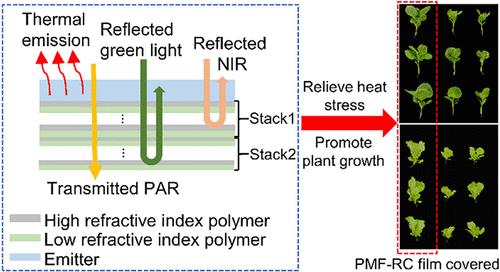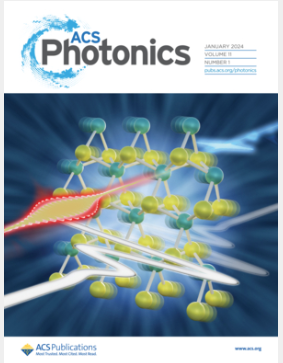A Low-Cost and Large-Scale Producible Polymer Multilayer Radiative Cooling Film for Reducing Plant Heat Stress
IF 6.7
1区 物理与天体物理
Q1 MATERIALS SCIENCE, MULTIDISCIPLINARY
引用次数: 0
Abstract
The greenhouse effect exacerbates plant heat stress, which poses a serious threat to global food production and atmospheric cycling. Spectrally selective radiative cooling films have been proven to have great potential in alleviating plant heat stress. However, their high cost and slow production speeds due to vacuum-based fabrication techniques have hindered widespread application. Here, we propose a strategy to reduce plant heat stress by using a polymer multilayer radiative cooling film. This film consists of two spectrally selective polymer multilayer film stacks and a polymer emitter. The polymer multilayer film stacks selectively transmit photosynthetically active radiation (52% for wavelengths of 0.4–0.48 μm and 85% for wavelengths of 0.6–0.7 μm) to boost photosynthesis, and the polymer emitter has high infrared emissivity to achieve excellent cooling performance. Field experiments indicated that this film reduces air temperature by 2.3–5.0 °C and the temperature at 3 cm below the soil surface by 2.1–4.1 °C, decreasing soil water evaporation by 11.2–32.4%. Consequently, plant biomass yield increases by 21.1–195.9%. Furthermore, the polymer multilayer radiative cooling film prepared by multilayer coextrusion has the advantages of low cost, fast processing speed, rich variety of candidate materials, and a simple structure. This work accelerates the process of large-scale practical application of passive radiative cooling technology in alleviating plant heat stress and promoting plant growth.

一种低成本、可大规模生产的降低植物热胁迫的聚合物多层辐射冷却膜
温室效应加剧了植物热应激,对全球粮食生产和大气循环构成严重威胁。光谱选择性辐射冷却膜在缓解植物热胁迫方面具有很大的潜力。然而,由于真空制造技术,它们的高成本和缓慢的生产速度阻碍了它们的广泛应用。在此,我们提出了一种利用聚合物多层辐射冷却膜来减少植物热应激的策略。该薄膜由两个光谱选择性聚合物多层膜堆和一个聚合物发射器组成。聚合物多层膜堆选择性透射光合有效辐射(在0.4 ~ 0.48 μm波长范围内为52%,在0.6 ~ 0.7 μm波长范围内为85%)促进光合作用,聚合物发射器具有较高的红外发射率,实现了优异的制冷性能。田间试验结果表明,该膜可使空气温度降低2.3 ~ 5.0℃,土壤表面以下3cm处温度降低2.1 ~ 4.1℃,土壤水分蒸发量减少11.2 ~ 32.4%。因此,植物生物量产量提高21.1-195.9%。此外,多层共挤法制备的聚合物多层辐射冷却膜具有成本低、加工速度快、候选材料种类丰富、结构简单等优点。本工作加快了被动辐射冷却技术在缓解植物热胁迫、促进植物生长方面大规模实际应用的进程。
本文章由计算机程序翻译,如有差异,请以英文原文为准。
求助全文
约1分钟内获得全文
求助全文
来源期刊

ACS Photonics
NANOSCIENCE & NANOTECHNOLOGY-MATERIALS SCIENCE, MULTIDISCIPLINARY
CiteScore
11.90
自引率
5.70%
发文量
438
审稿时长
2.3 months
期刊介绍:
Published as soon as accepted and summarized in monthly issues, ACS Photonics will publish Research Articles, Letters, Perspectives, and Reviews, to encompass the full scope of published research in this field.
 求助内容:
求助内容: 应助结果提醒方式:
应助结果提醒方式:


